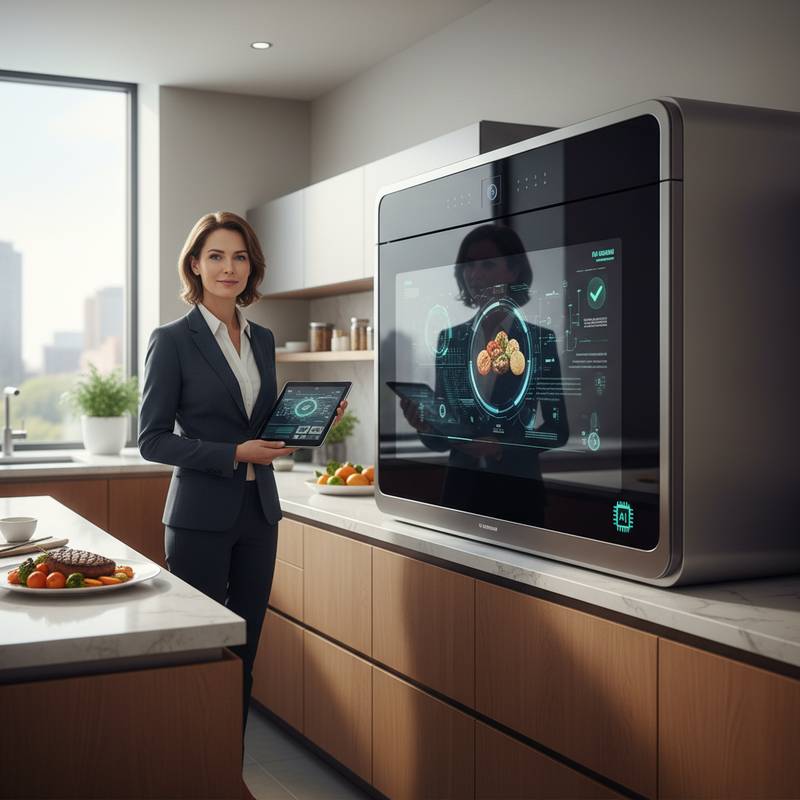Smart Ovens with AI for Ultimate Kitchen Fire Prevention
Smart homes evolve rapidly, and the kitchen emerges as one of the most intelligent areas in the residence. Among recent innovations, smart ovens powered by artificial intelligence transform cooking methods and enhance safety measures. In numerous households, unattended cooking ranks as a primary cause of kitchen fires. The latest smart ovens alter this scenario through predictive safety features, real-time monitoring, and automated prevention mechanisms that operate seamlessly.
The Safety Problem in Modern Kitchens
Cooking serves as a daily activity and a principal source of residential fire incidents. Conventional ovens depend solely on human vigilance and timing. A minor distraction, an overlooked timer, or an abandoned pan can rapidly lead to smoke and flames. Standard safety elements, such as automatic shut-off, frequently activate too late to prevent damage.
Smart ovens introduce a proactive strategy where prevention occurs well before hazards manifest. Rather than relying on heat sensors or alarms alone, these devices examine cooking patterns, temperatures, and food types to identify potential risks early. The objective remains straightforward: to render the kitchen connected and actively secure.
How Artificial Intelligence Enhances Oven Safety
Contemporary smart ovens incorporate cameras, sensors, and machine learning algorithms to assess internal activities. These systems distinguish between roasting vegetables, baking bread, or broiling meat. Subsequently, they adjust temperature, timing, and humidity levels to achieve optimal outcomes. Critically, they surveil these conditions for indicators of overcooking or burning.
Upon detecting smoke formation or a sudden temperature increase, the oven reduces heat or deactivates completely. Certain models dispatch notifications to smartphones, smartwatches, or voice assistants for immediate user response. This integration of continuous monitoring and remote access establishes a robust safety framework, effective even during absences from the kitchen.
Smart Recognition and Intelligent Alerts
A standout advancement in these ovens involves visual recognition capabilities. Integrated cameras and neural processing units evaluate food shapes, colors, and textures. This enables the oven to determine proper cooking progress or detect incipient burning.
Consider baking a pizza where the crust darkens unevenly; the oven may decrease temperature on the affected side or issue a repositioning alert via its companion application. If a recipe specifies a particular temperature range, the oven maintains adherence without deviation. Such precision minimizes smoke accumulation and fire risks.
Manufacturers employ AI models trained on extensive cooking datasets. These systems identify not only foods but also cookware materials and misuse patterns. For example, should a plastic container enter the oven inadvertently, the device detects it and withholds heat activation. This preventive approach surpasses capabilities of traditional sensors.
Real-World Examples of Smarter Cooking Safety
Multiple brands now market these intelligent ovens. GE Profile, Samsung, and Bosch offer models with embedded cameras and application-based controls emphasizing safety. Additional firms explore cloud-based analysis, transmitting data to networks that enhance safety algorithms progressively.
One notable instance features an oven employing visual recognition to spot smoke patterns prior to human detection. It activates ventilation fans automatically and alerts the user via mobile notification. Another variant tracks ambient air quality and modulates cooking temperatures to avert oil overheating. These functionalities integrate fire prevention into routine smart cooking.
Why Consumers Prioritize This Technology
Analyst surveys indicate that safety ranks among the top three factors influencing purchases of smart cooking appliances. Consumers value convenience alongside reassurance. Busy families, older homeowners, and residents of multi-unit structures benefit from ovens that intervene autonomously.
The technology aligns with trends in remote oversight. Users preheat ovens en route home, view live feeds, or deactivate units remotely if needed. This automation fosters secure practices without demanding perpetual supervision.
Overcoming Barriers to Adoption
Despite compelling advantages, obstacles persist. Smart ovens cost more than basic units, and connectivity concerns arise for some. Privacy issues, particularly with cameras, prompt hesitation. Producers counter these by implementing data encryption, camera disable options, and localized processing to retain information on-device.
Energy efficiency further justifies the expense. Optimized cooking conserves heat and accelerates processes, reducing electricity consumption and operational costs. For purchasers, this synergy of savings and security facilitates decisions.
Everyday Benefits Beyond Fire Prevention
Safety draws primary attention, yet the overall user experience proves equally compelling. Cooking yields consistent results, simplifies recipe adherence, and enhances predictability. Ovens recommend preheat settings, prompt tray rotations, and provide energy usage summaries.
Voice controls prove invaluable for households with children or seniors. Commands to halt cooking, set timers, or engage keep-warm modes require no physical interaction, minimizing errors. As usage continues, the oven adapts to individual preferences, streamlining daily tasks.
Integrating Smart Ovens into Your Routine
Adopting a smart oven extends beyond acquiring advanced equipment; it establishes a responsive, protective kitchen environment. Select models equipped with temperature surveillance, visual identification, and overheat safeguards.
Pairing with existing devices, such as smoke detectors or central hubs, strengthens the safety ecosystem. Envision the oven identifying smoke, engaging an air purifier, and notifying you preemptively. These AI-driven ovens elevate cooking standards, rendering unattended fire incidents increasingly obsolete.
